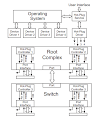Modifying U-Boot
================
Configuration files
The important configuration information for U-Boot is defined in the file:
include/configs/<board>.h
For example, the Espresso board default configuration file is:
include/configs/BOARD-NAME.h
This file defines such things as the memory layout, default baud rate, the U-Boot features that are included in the build, and so forth. Refer to the README file for a description of the options defined in the configuration file.
Board FLASH1 RAM2
U-Boot code U-Boot env | memory start U-Boot base
BOARD-NAME 0xA0000000-0xA003FFFF 0xA0040000-0xA003FFFF | 0x84000000 0x85F00000
1 Flash addresses are given as P2 (unchached) addresses for specific VENDOR.
2 RAM addresses are given as P1 (cached) addresses for specific VENDOR.
Code organization
The target-specific code is held in the following directories:
include/configs/<board-config>.h Board configuration header file
board/<board> Board files
cpu/<cpu> CPU files
cpu/<cpu>/<soc> SoC files
lib_<arch> Architecture support files
include/asm-<arch> Architecture headers
The following example is for the CUSTOME board:
include/configs/BOAR-NAME.h Board configuration header file
board/BOARD-NAME/ Board-specific files
config.mk Defines base address for U-boot in memory
BOARD-NAME.c Board specific initialization
Makefile
sconsole.c Used if no physical serial port exists
sconsole.h
u-boot.lds Linker script
init-BOARD-NAME.S Memory/SoC configuration table
cpu/sh4_1xx CPU files
config.mk CPU make flags
cpu.c CPU functions
interrupts.c Interrupt routines (not needed for sh4)
Makefile
start.S Main CPU entry point
init-st40common.S Common configuration code
cpu/sh4_1xx/sti5528 SoC files
Makefile
sti5528.c SoC specific functions (for example, reset)
lib_sh4 Architecture support files
board.c Generic board initialization code
cacheops.S
io.c
io_generic.c
linkage.h
memchr.S
memcpy.S
memmove.S
memset.S
sh4_linux.c Code for booting sh4 linux kernel
strlen.S
time.c Generic code for reading TMU
include/asm-sh4 Architecture headers
Porting U-Boot to a new board
==============================
The process of porting U-Boot to a new board consists of the following steps:
1:Choose an existing board which is most similar to the new board.
2:Copy the following files and directories using the name of the new board. For instance, change:
==========================================================================================
Old name New name
==========================================================================================
board/<existing-board> board/<new-board>
include/configs/<existing-board>.h include/configs/<new-boad>.h
3:Rename the files in board/<new-board> to match the name of the new board.
4:Modify board/Makefile to match the name of the new board.
5:Modify the memory initialization file: board/init-<new-board>.S.
6:Modify the board initialization file: board/<new-board>.c.
7:Modify the configuration file include/configs/<new-board>.h to match the memory organisation and peripherals of the new board.
8:Modify the value of TEXT_BASE in board/stb7100mboard/config.mk. This variable defines the SDRAM load address
Modifying the memory initialization file
==========================================
Very early in the boot sequence, the bootstrap calls the function init_ram to configure all the critical SoC and board devices. This is in order to enable U-Boot to be copied from Flash to SDRAM and start executing. This function is normally defined in the file board/init-<boardname>.S.
For ST40 targets the structure of this file is typically as follows:
-----------------------------------------------------------------------------------------------------
#define _SH4REG_ASM_
/* Include some register definitions for this device */
#include "asm/stb7100reg.h"
/*
Include the common memory initialization code for this SOC.
This file contains the "init_ram" function which uses the
__memory_setup_table defined below to do the appropriate memory setups.
*/
#include "../../cpu/sh4_2xx/stb7100/init-stb7100common.S"
.balign 32
__memory_setup_table:
/* Define memory config table */
POKE_LONG(STB7100_CLOCKGENA_LOCK, 0xc0de)
OR_LONG(STB7100_CLOCKGENA_PLL0_CFG, 0x00100000)
UPDATE_LONG(STB7100_CLOCKGENA_PLL0_CFG, 0xfff7ffff, 0)
UPDATE_LONG(STB7100_CLOCKGENA_PLL0_CFG, 0xfff80000, 0x06 | (0x3b << 8) | (0x0 << 16))
OR_LONG(STB7100_CLOCKGENA_PLL0_CFG, 0x00080000)
WHILE_NE(STB7100_CLOCKGENA_PLL0_STATUS, 0x00000001, 0x00000001)
UPDATE_LONG(STB7100_CLOCKGENA_PLL0_CFG, 0xffefffff, 0)
POKE_LONG(STB7100_CLOCKGENA_LOCK, 0x0)
...
END_MARKER
-----------------------------------------------------------------------------------------------------
Operation Function
=====================================================================================================================
POKE_LONG(A, V) *(*long)(A) = V;
POKE_SHORT(A, V) *(*short)(A) = V;
POKE_CHAR(A, V) *(*char)(A) = V;
OR_LONG(A, V) *(*long)(A) |= V;
UPDATE_LONG(A, MASK, V) *(*long)(A) = (*(*long)(A) & MASK) | V;
POKE_UPDATE_LONG(A1, A2, MASK, SHIFT, V) *(*long)(A1) = ((*(*long)(A2) & MASK) << SHIFT) | V;
WHILE_NE(A, MASK, V) while( (*(*long)(A1) & MASK) != V) {;}
IF_DEVID(V) If the device ID config register matches V then do the following memory operations until the next ELSE or ENDIF, otherwise execute the operations between the next ELSE and ENDIF.Currently supported for 710X targets only
IF_NOT_DEVID(V) If the device ID config register does NOT match V then do the following memory operations until the next ELSE or ENDIF, otherwise execute the operations between the next ELSE and ENDIF.Currently supported for 710X targets only
ELSE
ENDIF
END_MARKER marks end of table
Modify this table to match the target SoC target board combination.
The ST200 memory setup is very similar to the ST40, expect that it has an extra table _xpu_mmu_setup_table. This table sets up the MMU (and may also require changing).
Modifying the board initialization file
After U-Boot has been relocated to SDRAM, the initial bootstrap code sets up a stack and calls the C function start_<cpu>boot (see lib_<cpu>/board.c). This function then calls a number of initialization functions including the function board_init (which is defined in the file board/<boardname>/<boardname>.c).
The file board/<boardname>/<boardname>.c contains a number of functions that must be modified to match the target board. Typically, these functions set up PIO pins for serial ports, do any EPLD programming required, reset devices and provide functions for enabling or disabling writes to Flash.




0 Comments